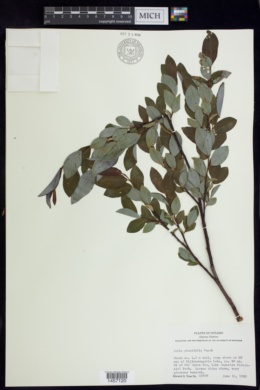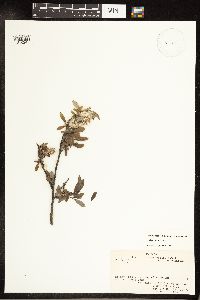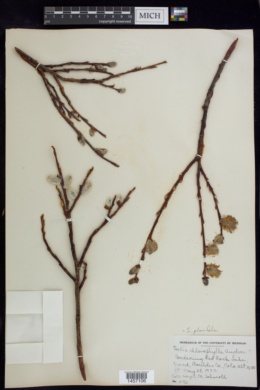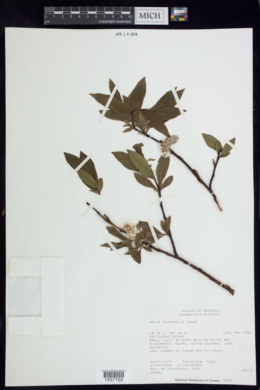Salix planifolia
|
|
|
|
Family: Salicaceae
diamondleaf willow, more...Tea-Leaf Willow, plainleaf willow
[Salix chlorophylla Anderss., moreSalix chlorophylla var. monica (Bebb) Flod., Salix chlorophylla var. nelsonii (Ball) Flod., Salix chlorophylla var. pychnocarpa (Anderss.) Anderss., Salix monica Bebb, Salix nelsonii Ball, Salix pennata Ball, Salix phylicifolia subsp. planifolia (Pursh) Hiitonen, Salix phylicifolia var. monica (Bebb) Jepson, Salix phylicifolia var. pennata (Ball) Cronq., Salix planifolia var. monica (Bebb) Schneid., Salix planifolia var. nelsonii (Ball) Ball ex E.C. Sm., Salix planifolia var. pennata (Ball) Ball ex Dutilly, Lepage & Daman, Salix pychnocarpa Anderss.] |
Shrubs or trees, 0.1-9 m, (sometimes forming clones by layering). Stems (sometimes decumbent); branches yellow-brown, red-brown, or violet, not to strongly glaucous, glabrous or pubescent; branchlets yellow-brown, red-brown, or violet, glabrous, pilose, pubescent, moderately densely villous, or short-silky, (buds caprea-type). Leaves: stipules (sometimes marcescent), rudimentary or foliaceous (small and usually brownish) on early ones, rudimentary or foliaceous on late ones, (narrowly ovate to oblong, 1-2.5(-4.5) mm), apex acute; petiole shallowly grooved adaxially, 2-9(-13) mm, glabrous, pilose, or short-silky adaxially; largest medial blade (sometimes hemiamphistomatous), narrowly oblong, narrowly elliptic, elliptic, or oblanceolate, 20-36-65 × 5-13-23 mm, 1.7-2.8-4.7 times as long as wide, base cuneate or convex, margins sometimes slightly revolute basally, entire, or, sometimes, crenulate or serrulate, apex acute, acuminate, or convex, abaxial surface glaucous, glabrous or sparsely silky, hairs (white, sometimes also ferruginous) straight or wavy, adaxial highly glossy, glabrous or sparsely short-silky; proximal blade margins entire; juvenile blade reddish or yellowish green, glabrous, puberulent, pubescent, or densely long-silky abaxially, hairs white, sometimes also ferruginous. Catkins flowering before leaves emerge; staminate stout, subglobose, or globose, 12-41 × 10-20 mm, flowering branchlet 0-4 mm; pistillate densely flowered, slender, or stout to globose, 15-67 (-70 in fruit) × 8-18 mm, flowering branchlet 0-6 mm; floral bract dark brown or black, 1-3.2 mm, apex acute, convex, or rounded, sometimes 2-fid, abaxially hairy, hairs straight. Staminate flowers: adaxial nectary narrowly oblong or oblong, 0.4-1.1 mm; filaments distinct, glabrous or sparsely hairy basally; anthers purple turning yellow, shortly cylindrical, 0.5-0.7 mm. Pistillate flowers: adaxial nectary oblong, square, or ovate, 0.4-1.3 mm, shorter to longer than stipe; stipe 0.3-0.8 mm; ovary pyriform, short- to long-silky, sometimes slightly bulged below styles; ovules 11-16 per ovary; styles 0.5-2 mm; stigmas slenderly to broadly cylindrical, 0.36-0.52-1.1 mm. Capsules (2.5-)5.5-6 mm. 2n = 76, 57. Flowering early May-late Jun. Arctic, alpine, subalpine, and boreal meadows and riverbanks, streams, seeps, snowflush areas, treed bogs, fens, sandy-loam, rocky igneous and limestone substrates; 100-4000 m; St. Pierre and Miquelon; Alta., B.C., Man., Nfld. and Labr., N.W.T., Nunavut, Ont., Que., Sask., Yukon; Alaska, Ariz., Calif., Colo., Idaho, Maine, Mich., Minn., Mont., Nev., N.H., N.Mex., Oreg., S.Dak., Utah, Vt., Wash., Wis., Wyo. Variety monica applies to the diminutive alpine form that sometimes is recognized in the southern Rocky Mountains (S. J. Brunsfeld and F. D. Johnson 1985); it occurs at higher elevations (2200-4000 m) and is characterized by low growth form (0.14-1 m) and smaller, slightly broader leaves. Although it can be distinctive, it is morphologically confluent with the typical species. B. G. O. Floderus (1939) may be correct in characterizing it as an alpine ecotype. Salix planifolia and S. pulchra are closely related. Their ranges overlap in northwestern Canada, from northern British Columbia across the southern quarter of the Yukon and northeastward into the Great Bear Lake area. Specimens identified as S. pulchra occur as far northeastward as Coppermine and northeast of Bathurst Inlet; S. planifolia has been recognized in the Mackenzie Delta and Eskimo Lake regions, Northwest Territories. Outlying records should be treated with caution because identification of individual specimens out of context may not be definitive. G. W. Argus (1969, 1973) treated these taxa as subspecies based on their intergradation in northwestern British Columbia, their tetraploid chromosome number, and their similar leaf flavonoid chromatographic patterns, but this taxonomy needs reconsideration. The primary differences between the two species are stipule size, shape, and persistence and the pubescence on juvenile leaves. Stipules of Salix planifolia are oblong to narrowly elliptic or obovate, 0.8-3 mm (or -4.5 mm at Back River, Northwest Territories), distinctly shorter than petioles, and rarely marcescent for more than one year; stipules of S. pulchra are linear to narrowly oblong, 3-32 mm, usually longer than petioles, and usually marcescent for two or more years. Juvenile leaves of S. planifolia are usually more densely hairy, but vary from glabrescent to sparsely or very densely pubescent or long-silky, whereas juvenile leaves of S. pulchra are usually glabrous or, sometimes, sparsely hairy. The occurrence of rhombic mature leaf blades in S. pulchra sometimes is distinctive, but overlap in leaf shape between the two taxa is very great. The area of geographic overlap in Yukon and western Northwest Territories is large, but evidence suggests that there the two species may be separated by elevation. In the vicinity of Whitehorse, Yukon, Salix pulchra occurs at higher elevations (1400-1900 m) th Plant: shrub; to 4 m tall, erect or decumbent on ground; branches yellow- or red-brown, glabrous to becoming so; branchlets yellow- to dark red-brown, glabrous or short-silky Leaves: stipules leaflike to lacking; petioles glabrous or pilose, 2-9 mm long; proximal leaves on vegetative or flowering branchlets entire or gland-dotted; young leaves glabrous or silky; mature blade narrowly oblong to elliptic, 20-48 mm long, 5-15 mm wide, 1.5-5 times as long as wide, the lower surface glaucous, glabrous or sparsely silky becoming glabrous, the hairs white or white and rust-colored, the upper surface highly glossy, sparsely silky becoming glabrous, the base acute, the margins flat to revolute, entire to crenate, with 2-8 glands per cm, the apex acute INFLORESCENCE: cylindrical to subspherical catkins; precocious; floral bracts brown or black, 1-3.2 mm long, with straight hairs, the apices acute to obtuse Flowers: STAMINATE FLOWERS in densely flowered catkins 11-22 mm long, sessile or on flowering branchlets up to 3 mm long; filaments glabrous or hairy; nectary broad, 0.4-0.8 mm long. PISTILLATE FLOWERS in densely flowered catkins 15-60 mm long, sessile or on flowering branchlets to 2 mm long; ovaries silky; stigmas 0.36-0.92 mm long; styles 0.5-1.8 mm long; stipes 0.3-0.8 mm long; nectary 1, slender to broad, 0.4-1.3 mm long, shorter, equal to, or longer than stipe Fruit: lanceolate to ovate REFERENCES: Argus, George W. 1995. SalicaceaePart 2. Salix. J. Ariz. - Nev. Acad. Sci. 29(1): 39 Common Name: tea-leaf willow Duration: Perennial Nativity: Native Lifeform: Shrub General: Shrub up to 4 m (13 ft) tall (but rarely over 1 m), erect or decumbent; branches yellow- or red-brown, shiny; branchlets yellow- to dark red-brown, glabrous or short- silky. Leaves: Alternate, simple, narrowly oblong or elliptic, 2-5.4 cm long, 5-23 mm wide, 1.5-4 times as long as wide, upper surface shiny and sparsely silky but becoming glabrous, lower surface glaucous and glabrous or sparsely silky becoming glabrous, the hairs white or white and rust colored, margins entire to crenate, base acute, apex acute. Flowers: Appearing before the leaves; floral bracts brown or black, hairy, the apices acute to obtuse; pistillate flowers in densely flowered catkins 1.5-6 cm long; stipes 0.3-0.8 mm long; ovaries silky; styles 0.5-1.8 mm long; staminate flowers in densely flowered catkins 1.1-2.2 cm long; stamens 2 per flower, filaments glabrous or hairy. Fruits: na Ecology: Found in meadows, stream banks from 9,500-11,000 ft (2896-3353 m), flowers May-June. Distribution: Apache County; Canada, western, north-central, and northeastern U.S. Notes: One subspecies in Arizona-ssp. planifolia. Distinguished from other subalpine species in having shiny, red year- old branchlets. Salix arizonica (Arizona willow) is another low-growing (usually < 1 m) subalpine species, distinguished by pilose to villous branchlets, leaf margins that are gland-dotted or serrate with 7-21 glands or teeth per centimeter, and bases usually cordate or sometimes rounded. Salix arizonica is a rare, protected species restricted in our region to the White Mountains of Apache County from 9,000-11,000 ft (2743-3353 m). Salix boothii (Booth-s willow) is very similar to S. arizonica, but is generally taller (1-6 m), with leaf margins entire or serrulate with 2-12 glands or teeth per centimeter, bases acute to rounded or rarely cordate. Salix boothii is also restricted in our area to the White Mountains, from 9,500-10,500 ft (2896-3200 m). Editor: Springer et al. 2011 Erect shrub 1-3 m; twigs stoutish, divaricate, chestnut to red-purple or brown, puberulent at first, soon glabrous and shining; stipules small or more often none; petioles 4-10 mm; lvs rather crowded, narrowly elliptic or elliptic-oblanceolate or narrowly obovate, 3-6(-8) נ1-2.5(-3.5) cm, acute at both ends or the largest obtuse at base, entire or sometimes ±crenate-serrulate, glabrous and glossy above, sparsely sericeous to glabrous and glaucescent beneath, the primary lateral veins numerous, closely spaced; catkins precocious (reputedly sometimes coetaneous-not provided for in the key), sessile, 2.5-5 cm; scales 2-3 mm, black, long-villous; stamens 2; frs lanceolate, 4-7 mm, finely sericeous, subsessile, the pedicels only 0.1-0.5 mm; style 1-1.5 mm; 2n=76. Wet meadows, lake-shores, streambanks, and rocky places; Lab. to Yukon, s. to the mts. of Me., N.H., and Vt., and to n. Minn. and the w. cordillera. (S. phylicifolia ssp. planifolia) Gleason, Henry A. & Cronquist, Arthur J. 1991. Manual of vascular plants of northeastern United States and adjacent Canada. lxxv + 910 pp. ©The New York Botanical Garden. All rights reserved. Used by permission. |
































































































